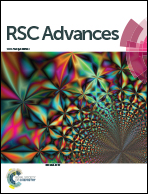Synthesis of novel imidazole-based triheterocycles via a domino Ugi/Michael reaction and silver-catalyzed heteroannulation†
Abstract
An efficient and diversity-oriented synthetic strategy for novel triheterocyclic imidazo-pyrrolo-pyrazine/diazepine/diazocine derivatives is elaborated. The process utilizes a domino four-component Ugi reaction/Michael reaction of imidazole-2-carbaldehyde, propargyl amines, 2-alkynoic acids and isonitriles to deliver functionalized imidazole-pyrrolones, which upon a silver-catalyzed heteroannulation in aqueous medium under microwave irradiation furnishes the desired triheterocycles in good to excellent yields.



 Please wait while we load your content...
Please wait while we load your content...